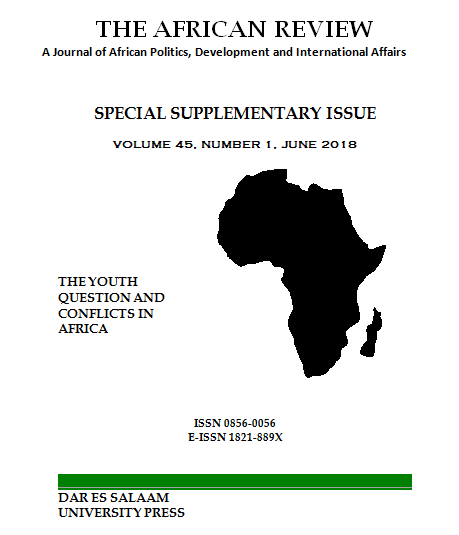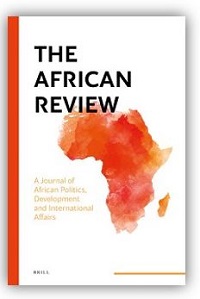Why They Don ' t Fight! Experiences and Responses of the Youth in Uganda to discrimination, injustice and exclusion
Abstract
This paper explores mechanisms that the youth utilize to respond to exclusion, discrimination and injustice without violence. Through a comparative study of Kampala and Jinja districts, the findings reveal resilience, adaptation and social bonding as some of the agency-based mechanisms that influence non-participation in violence. Resilience as a response to exclusion, discrimination and injustice is both a process and an outcome, during which internal and external factors influence victims to adapt and build social bonds that increase the preference for non-violence towards selfadvancement. Proactive action and setting clear expectations are internal factors that drive self-regulation and problem-solving by individuals and groups who choose not to fight. Religion, culture and gender are some of the external factors that facilitate adaptation through safety and restoration of a sense of belonging, self-esteem and security in the place of exclusion and discrimination. These factors can be integrated in state policies, community programs and family practices to support reduction in youth vulnerability and violent responses to exclusion, discrimination and injustice.
Keywords: Uganda, Youth, Non-Violence, Resilience, Social Bonding
Sentongo Ashad, Executive Director, Genocide and Mass Atrocity Prevention Support, Email: ashadsent@gmail.com
References
Abbink, J. 2005. Being Young in Africa: The Politics of Despair and Renewal. In Abbink and van Kessel (eds.), Vanguard or Vandals.
Baker G. 2001. Uganda: The Marginalization of Minorities. Minority Rights Group International, United Kingdom.
Balsano A. Theokas C, Lerner J. and Lerner R. 2009. "Patterns of Early Adolescents ' Participation in Youth Development Programs Having Positive Youth Development Goals." Journal of Research on Adolescence, 19(2): 249 €“259.
Banks, N. 2015. What Works for Young People's Development? A Case Study of BRAC's Empowerment and Livelihoods for Adolescent Girls Programme in Uganda and Tanzania. WPI Working Paper 212. University of Manchester, UK. Brooks World Poverty Institute.
Bennett A. 2004. "Case Study Methods: Design, Use, and Comparative Advantages." Journal of Models, numbers, and cases: Methods for studying international relations, 19-55.
Bhulai R. Barakat, C. and Zeiger S. 2014. The Roles of Families and Communities in Strengthening Community Resilience Against Violent Extremism. Hedayah and the Global Center on Cooperative Security.
Bizan S. Bowers E. and Lerner R. 2010. "One Good Thing Leads to Another: Cascades of Positive Youth Development Among American Adolescents." Development and Psychopathology, 22(4): 759 €“770.
Calfas, K. and Taylor, W. 1994. "Effects of Physical Activity on Psychological Variables in Adolescents", Pediatric Exercise Science, 6(4): 406 €“423.
Charmaz, K. 2000. "Grounded theory: Objectivist and Constructivist Methods," In Denzin N. and Lincoln, Y. (eds.), Handbook of Qualitative Research. Thousand Oaks, CA: Sage.
Chayes, A. and Chayes H. 1995. The New Sovereignty: Compliance with International Regulatory Agreements. London: Harvard University Press, London.
Child Soldiers in Uganda, by SOS Children's Villages UK. http://www.childsoldier.org/children-in-conflict-child-soldiers-in-uganda
Chomsky, N. 1967. The Legitimacy of Violence as a Political Act? Noam Chomsky debates with Hannah Arendt, Susan Sontag, et al. December 15, 1967. https://chomsky.info/19671215/
Chriss J. 2007. "The Functions of the Social Bond," Sociological Quarterly, 48(4): 689712
Deutsch, M. 2000. "Cooperation and Competition," In Deutsch, M. Coleman P. and Murcus, E. (eds). The Handbook of Conflict Resolution: Theory and Practice. San Francisco: Jossey-Bas Publishers.
Dowd, C. 2017. How Does Work Feature in Literature on Youth Participation in Violence? Institute of Development Studies, Working Paper 485, March 2017
Durkheim, E. 1965. The Elementary Forms of the Religious Life. London: Collier Macmillan Publishers.
Elliott S. 1994. Youth Violence: An Overview. Center for the Study and Prevention of Violence, University of Colorado: Institute of Behavioral Science.
Festinger, L. 1957. A Theory of Cognitive Dissonance. Stanford, CA: Stanford University Press.
Giddens, A. 1984. The Constitution of Society. Berkeley: University of California Press.
Gestsdottir, S. and Lerner, R. (2007). "Intentional Self-regulation and Positive Youth Development in Early Adolescence: Findings from the 4-H study of Positive Youth Development," Developmental Psychology, 43(2): 508-521.
Gurr, T. 1970. Why Men Rebel. Princeton, NJ: Center of International Studies, Princeton UP.
Hardman, A. Jones, C. and Jones, R. 2010. "Sports Coaching, Virtue Ethics and Emulation." Physical Education and Sport Pedagogy, 15(4): 345 €“359.
Heise, D. 1972. "Employing Nominal Variables, Induced Variables, and Block Variables in Path Analysis., Sociological Methods and Research, 1(2): 147-173.
Ho-Won, J. 2000. Sources of Social Conflict.. Burlington, Vt: Ashgate Jua, N. 2003. "Differential Responses to Disappearing Transitional Pathways: Redefining Possibility among
Cameroonian Youths," African Studies Review 46(2): 13-36.
Korongo, A. 2012.. Regional Report on Youth Policies and Violence Prevention in the Great Lakes Region. 2nd Year, UNESCO, http://unesdoc.unesco.org/images/0021/002170/217098e.pdf
Lee, T. Chau K. and Wai Man K. 2011. Resilience as a Positive Youth Development Construct: A Conceptual Review. Department of Applied Social Studies, City University of Hong Kong.
Major B. Quinton, J. and Shannon K. 2002. "Antecedents and Consequences of Attributions to Discrimination: Theoretical and Empirical Advances," Advances in Experimental Social Psychology, 34: 251-330.
Mugaju, J. 2000. "An Historical Background to Uganda's No-Party Democracy," In Mugaju, J. and Onyango J. (eds). No-party democracy in Uganda: Myths and Realities.. Kampala: Fountain Publishers.
Nabwiso, F. 1990. "The evolution of the Kyabazinga of Busoga." In Some Historical Facts about Busoga. Busoga Cultural Research Centre, Jinja (U). Collection V-Acc. No. 00697
Nuwagaba, A. 2012. "Savings and Credit Cooperative Societies (SACCOS) as a Source of Financing Agriculture. Challenges and Lessons Learnt." Journal of Environment and Earth Science. 2(11):11.
Odell S. 2001. "Case Study Methods in International Political Economy," International Studies Perspectives, 2 (2): 161 €“176.
Phelps, E. Zimmerman, S. Warren, A, Jelicic, H. and Lerner, R. 2009. "The Structure and Developmental Course of Positive Youth Development (PYD) in Early Adolescence: Implications for Theory and Practice," Journal of Applied Developmental Psychology, 30(5): 571 €“584.
Rwenzori Forum for Peace and Justice (2016). http://rfpjuganda.net/rfpj-andinternational-launches-the-rwenzori-regional-violence-prevention-and-peacebuilding-agenda-2015-2018-13th-15th-april-2016/
Sandole, J. 1999. Capturing the complexity of conflict: dealing with violent ethnic conflicts of the post-cold war era. New York: Pinter.
Sentongo, A. and Bartoli, A. 2012. "Conflict resolution under the Ekika system of the Baganda in Uganda," In Integrating Traditional and Modern Conflict Resolution Experiences from selected cases in Eastern and the Horn of Africa. Africa Monograph Series. Series Number: 2/2012, Accord SA.
Smith, B. 2002. Vulnerability and Resilience as Predictors of Pain and Affect in Women with Arthritis. Dissertation Abstracts International Part B, 63(3).
Tajfel, H. 1981. Human Groups and Social Categories: Studies in Social Psychology. Cambridge: Cambridge University Press.
Tanbull, R. John, A. 2016. Where does violence leave youth and political leaders?. The New Vision. Added 18th January 2016 12:35 PM https://www.newvision.co.ug/new_vision/news/1415086/violence-leave-youthpolitical-leaders
United Nations Department of Economic and Social Affairs Population Division 2015. World Population Prospects: The 2015 Revision, Key Findings and Advance Tables, https ://esa.un.org/unpd/wpp/publications/files /key_findings _wpp_2015.pdf.
Wilson, A. and Michi, E. 2015. Youth and Violent Conflict: Society and Development in Crisis? A Strategic Review with a special focus on West Africa. Bureau for Crisis Prevention and Recovery. United Nations Development Programme
Downloads
Published
Issue
Section
License
Copyright © by Department of Political Science and Public Administration, University of Dar es Salaam
All rights reserved. No part of this publication may be reproduced or transmitted in any form or by any means, electronic or mechanical, including photocopying, recording, or any information storage or retrieval system, without permission in writing from the publisher, except for short extracts in fair dealing, for research or private study, critical scholarly review or discourse with an acknowledgement.
The African Review: A Journal of African Politics, Development and International Affairs [ISSN 0856-0056 (Print) & ISSN 1821-889X (Online)] is published bi-annually, June and December by the Department of Political Science and Public Administration, University of Dar es Salaam, P.O. Box 35042 €“ Dar es Salaam €“ Tanzania



